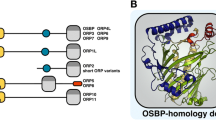Abstract.
OSBP (oxysterol-binding protein) and ORPs (OSBP-related proteins) constitute an enigmatic eukaryotic protein family that is united by a signature domain that binds oxysterols, sterols, and possibly other hydrophobic ligands. The human genome contains 12 OSBP/ORP family members genes, while that of the budding yeast Saccharomyces cerevisiae encodes seven OSBP homologues (Osh). Of these, Osh4 (also referred to as Kes1) has been the most widely studied to date. Recently, three-dimensional crystal structures of Osh4 with and without sterols bound within the core of the protein were determined. The core consists of 19 anti-parallel β-sheets that form a near-complete β-barrel. Recent work has suggested that Osh proteins facilitate the non-vesicular transport of sterols in vivo and in vitro, while other evidence supports a role for Osh proteins in the regulation of vesicular transport and lipid metabolism.This article will review recent advances in the study of ORP/Osh proteins and will discuss future research issues regarding the ORP/Osh family.
Similar content being viewed by others

Author information
Authors and Affiliations
Corresponding author
Additional information
Received 17 July 2007; received after revision 14 August 2007; accepted 12 September 2007
Rights and permissions
About this article
Cite this article
Fairn, G.D., McMaster, C.R. Emerging roles of the oxysterol-binding protein family in metabolism, transport, and signaling. Cell. Mol. Life Sci. 65, 228–236 (2008). https://doi.org/10.1007/s00018-007-7325-2
Published:
Issue Date:
DOI: https://doi.org/10.1007/s00018-007-7325-2



